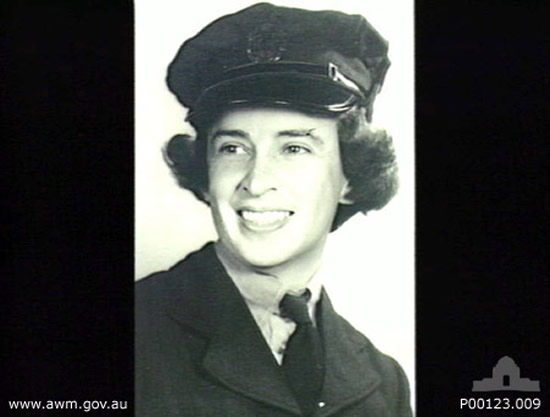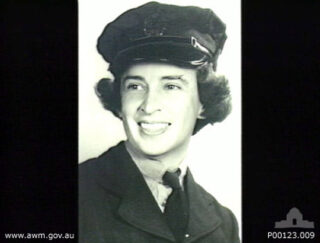- Entry type: Person
- Entry ID: AWE0485
Linnane, Joyce Enid (Joy)
(1919 – 2012)
- Occupation Servicewoman
Summary
Sergeant Joy Linnane served with the Women’s Auxiliary Australian Air Force (WAAAF) during World War II. She enlisted on 11 April 1942 and was discharged on 7 December 1945.
After the war Linnane joined the Sydney WAAAF Branch and has been a member since 1956. During that time she has held the positions of vice-president, treasurer, state councillor and delegate to country branches.
Details
The daughter of Thomas and Emily Linnane, Joy Linnane was educated at William Street High School where she obtained her Intermediate Certificate. Due to the Depression Linnane was unable to continue her education and she took a position as a shop assistant at Anthony Hordern’s emporium. Later she worked in the office of Elliott’s and the Australian Drug Company, while voluntarily studying international Morse code in her spare time.
Joy Linnane enlisted in the Women’s Auxiliary Australian Air Force (WAAAF) at Tempe on 11 April 1942. At the time the Central Bureau (in Melbourne) decided to form a series of wireless units in the South-West Pacific Area for the purpose of intercepting Japanese Morse code messages. Volunteers for ‘special work’ unspecified, were called for from both Royal Australian Air Force (RAAF) and WAAAF wireless operators. Linnane was selected, sworn in and then discovered she belonged to the Central Bureau of Intelligence for the duration of the war.
Linnane trained at the Melbourne Showgrounds with 12 others as a KANA (Japanese Morse code equivalent) intercept operator. Her first posting was to Point Cook where she was employed in the ‘hush hush’ hut. In the hut the staff intercepted naval traffic from Japanese submarines, working a rotation of four hours on and four hours off. In a taped interview on 17 August 1984, Linnane states:
It was not an easy course, but we all passed and were posted to Pt Cook. Our first assignment was to intercept all messages within range from the Japanese Navy. With a RAAF sergeant in charge we set up operations in a hut near the Sigs School, which became known as the ‘hush hush’ hut. This was because of the high level of security necessary and if there was a disadvantage in working for Intelligence, it was in being an isolated group, avoiding contact with ‘straight’ operators, as we wore the same Sparks on our sleeves, but were certainly on different wave lengths. However, this was minor and we were all dedicated and work-involved, even though with our small numbers we had to keep a 24 hour watch, working 4 hours on and 4 hours off, with no standdown for many months.
Linnane’s next posting was to No. 1 Wireless Unit Townsville in February 1943 intercepting air/ground traffic. Personnel were barracked at Roseneath. The surrounding bush was infested with cane toads and mosquitoes, the latter causing malaria fever. Due to their isolation there was no medical attention, but they helped each other. The intercept and intelligence operations rooms were situated at Stuart in a top-secret bush location. The concrete bomb-proof building was camouflaged as a farm house. Joy Linnane is quoted in The WAAAF in Wartime Australia (p. 230):
Here [at Stuart] we concentrated on air-ground activity. Each operator was given a frequency to monitor and as Jap planes took off from their bases [in and around New Guinea] and sent messages from the air back to them, we intercepted the messages, the D/F located their positions, the interpreters and code people extracted the information and in a matter of minutes, the nearest Squadrons were alerted and flew out to defend and attack. Quite often an operator could follow right through to the Kana ‘I am being attacked’ signal and perhaps silence thereafter.
In October 1944 General MacArthur requested for one of the Kana Intercept Wireless Units to form part of the Philippines invasion force. The War Cabinet refused permission for the WAAAF operators to join their RAAF counterparts at Leyte. Instead they were posted to Central Bureau Allied signals intelligence centre under General MacArthur’s command.
After the war Linnane became a member of the Sydney WAAAF Branch and has held many positions within the Association since joining in 1956. A State councillor for 18 years, Linnane has also been vice-president, treasurer and delegate to country branches. Before retiring to the Central Coast of New South Wales, she travelled extensively in Australia, the Pacific, Europe and the East. She was a voluntary teacher of public speaking for the Methodist Mission for eight years, and in this capacity entered the City of Sydney Eisteddfod successfully on four occasions. Later Linnane trained students, some of whom also competed at the Eisteddfod.
Linnane was awarded life membership in the Air Force Association and has been presented with the Certificate of Merit plus the WAAAF Sportsmanship Certificate. She also received a Certificate for Outstanding Achievement and a letter from The Honourable Paul Lucas MP in which he comments ‘Our society owes a great debt of gratitude, not only for the lives of allied personnel, that were saved by the shortening of the war, but also for the freedom that people like me and my family can enjoy as a result of the work and sacrifice of your generation.’
Archival resources
Digital resources
Published resources
- Book
-
Resource Section
- NO. 1 WIRELESS UNIT RAAF IN AUSTRALIA DURING WW2, Dunn, Peter, http://home.st.net.au/~pdunn/raaf/no1wu.htm
- LINNANE, JOYCE ENID, Department of Veterans' Affairs, 2002, http://www.ww2roll.gov.au/script/veteran.asp?ServiceID=R&VeteranID=936131
-
Resource
- Trove: Linnane, Joyce Enid (1919-), http://nla.gov.au/nla.party-768050
